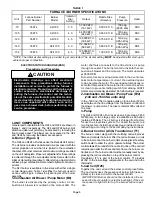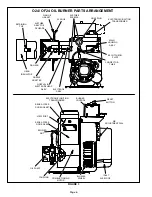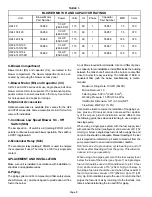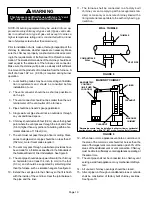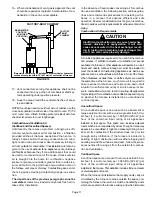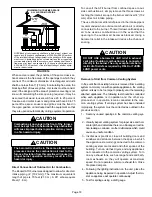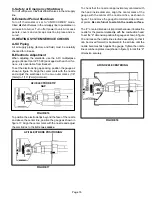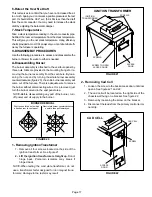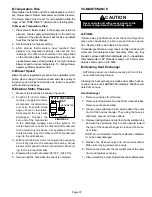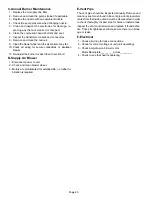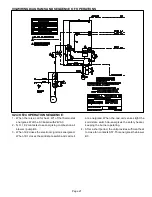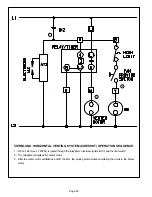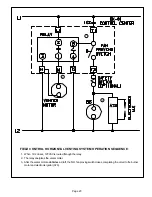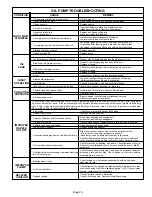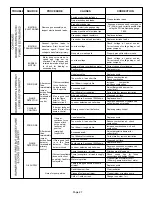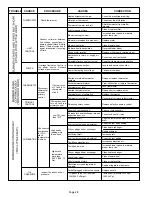
Page 13
EQUIPMENT IN CONFINED SPACE
ALL AIR FROM OUTSIDE
OUTLET AIR
INLET AIR
WATER
HEATER
CHIMNEY
OR OIL
VENT
FIGURE 14
NOTE-Each air duct opening shall have a free area of at least one
square inch (6.4 square centimeters) per 2,000 Btu (586 W) per hour
of the total input rating of all equipment in the enclosure. If the equip
ment room is located against an outside wall and the air openings
communicate directly with the outdoors, each opening shall have a
free area of at least one square inch (6.4 square centimeters) per
4,000 Btu (1172 W) per hour of the total input rating of all other equip
ment in the enclosure.
OIL
FURNACE
When ducts are used, they shall be of the same cross-sec
tional area as the free area of the openings to which they
connect. The minimum dimension of rectangular air ducts
shall be no less than 3" (76 mm). In calculating free area, the
blocking effect of louvers, grilles, or screens must be consid
ered. If the design and free area of protective covering is not
known for calculating the size opening required, it may be
assumed that wood louvers will have 20 to 25 percent
free area and metal louvers and grilles will have 60 to 75
percent free area. Louvers and grilles must be fixed in
the open position or interlocked with the equipment so that
they are opened automatically during equipment operation.
CAUTION
Combustion air openings in the front of the furnace
must be kept free of obstructions. Any obstruction
will cause improper burner operation and may result
in a fire hazard or injury.
CAUTION
The barometric shall be in the same atmospheric
pressure zone as the combustion air inlet to the
furnace. Deviation from this practice will cause im
proper burner operation and may result in a fire
hazard or injury.
Direct Connection of Outdoor Air for Combustion
The Beckett AFII burner was designed to allow for direct air
intake piping (4" [102 mm]). The maximum equivalent
length of pipe is 70 feet (21.3 m). A 90
elbow equals
6feet (1.8 m).
To convert the AFII burner from confined space to out
side combustion air, simply remove the three screws at
taching the inlet air scoop to the burner and insert 4" (102
mm) direct air intake piping.
The use of a barometric relief placed in the intake pipe is
recommended when outdoor combustion air is directly
connected to the burner. This will allow confined space
air to be used as combustion air in the event that the
opening to the outdoor air becomes blocked. Using a
barometric relief in the intake will reduce the chance of
sooting.
CAUTION
DO NOT USE a barometric draft relief in exhaust
vent pipe if outdoor combustion air is connected
directly to the burner. The only exception are baro
metric draft reliefs as required by FIELD or TJERN
LUND power vents.
Removal of Unit from Common Venting System
In the event that an existing furnace is removed from a venting
system commonly run with separate appliances, the venting
system is likely to be too large to properly vent the remaining
attached appliances. The following test should be conducted
while each appliance is in operation and the other ap
pliances not in operation remain connected to the com
mon venting system. If venting system has been installed
improperly, the system must be corrected as outlined in the
previous section.
1 - Seal any unused openings in the common venting sys
tem.
2 - Visually inspect venting system for proper size and hori
zontal pitch and determine there is no blockage or restric
tion, leakage, corrosion or other deficiencies which could
cause an unsafe condition.
3 - Insofar as is practical, close all building doors and
windows and all doors between the space in which
the appliances remaining connected to the common
venting system are located and other spaces of the
building. Turn on clothes dryers and any appliances
not connected to the common venting system. Turn
on any exhaust fans, such as range hoods and bath
room exhausts, so they will operate at maximum
speed. Do not operate a summer exhaust fan. Close
fireplace dampers.
4 - Following the lighting instruction on the unit, place the
appliance being inspected in operation. Adjust thermo
stat so appliance will operate continuously.
5 - Test for spillage using a draft gauge.





